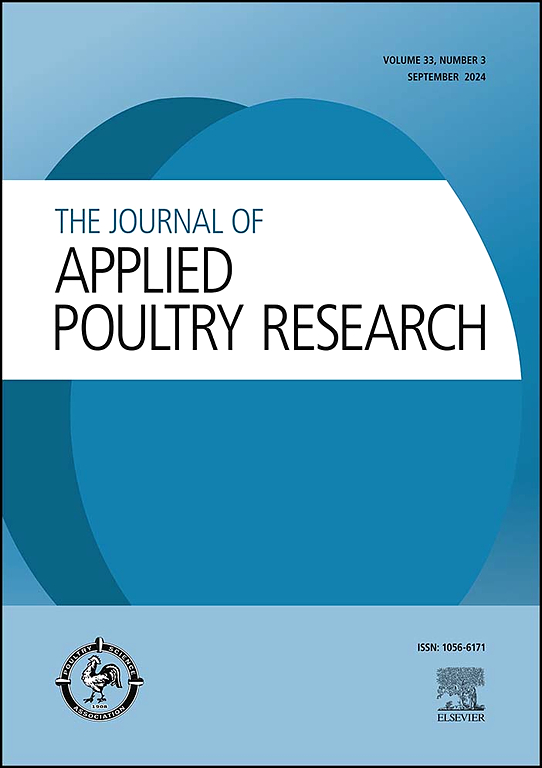Development of prediction equations for apparent metabolizable energy corrected for nitrogen of fish meal and poultry by-product meal in broiler chickens
IF 1.6
3区 农林科学
Q2 AGRICULTURE, DAIRY & ANIMAL SCIENCE
引用次数: 0
Abstract
This experiment was conducted to determine the AMEn content of fish meal (FM) and poultry by-product meal (PBM) samples from different origins to develop prediction equations based on the chemical composition. A total of 300 one-day-old male broiler chicks were randomly assigned to fifteen treatments (fourteen experimental diets and 1 reference diet) with 4 replicates of each treatment and 5 birds per replicate. In order to determine AMEn using a replacement method, the test diets consisted of 60% reference diet (based on corn and soybean meal), 38% FM or PBM samples, and 2% micro-ingredients. The broilers were fed the experimental diets for 4 d (24–27), and feces were collected on d 28. The AMEn values of the FM samples varied from 2,886 to 3,157 kcal/kg, and the range for the PBM was from 2,186 to 4,114 kcal/kg. The regression equation prediction of AMEn was determined by SPSS software. Finally, the equations AMEn = 35.658 × CP + 61.975 × EE (standard error of prediction [SEP]: 98.79; Adjusted R2: 0.89) and AMEn = 84.396 × EE + 21.221 × CP (SEP: 269.83; Adjusted R2: 0.93) were suggested to predict the AMEn for FM and PBM, respectively. These equations can save time and cost for poultry nutritionists to formulate the diets for broilers and serve as a reference to develop calibration equations for the predicted values of AMEn of FM and PBM for broiler chickens using near-infrared reflectance spectroscopy.
肉鸡摄入鱼粉和家禽副产品粉的表观代谢能(经氮校正)预测方程的开发
本实验旨在测定不同产地的鱼粉(FM)和家禽副产品粉(PBM)样品中的 AMEn 含量,并根据其化学成分建立预测方程。将 300 只一天龄的雄性肉用仔鸡随机分配到 15 个处理(14 种实验日粮和 1 种参考日粮),每个处理 4 个重复,每个重复 5 只。为了使用替代法测定 AMEn,试验日粮由 60% 的参考日粮(基于玉米和大豆粉)、38% 的 FM 或 PBM 样品和 2% 的微量成分组成。肉鸡饲喂试验日粮 4 天(24-27 天),第 28 天收集粪便。FM 样品的 AMEn 值介于 2,886 至 3,157 千卡/千克之间,PBM 样品的 AMEn 值介于 2,186 至 4,114 千卡/千克之间。利用 SPSS 软件确定了 AMEn 的回归方程预测值。最后,分别提出了 AMEn = 35.658 × CP + 61.975 × EE(预测标准误差 [SEP]:98.79;调整后 R2:0.89)和 AMEn = 84.396 × EE + 21.221 × CP(预测标准误差:269.83;调整后 R2:0.93)这两个方程来预测 FM 和 PBM 的 AMEn。这些方程可为家禽营养学家节省配制肉鸡日粮的时间和成本,并可作为利用近红外反射光谱法开发肉鸡 FM 和 PBM AMEn 预测值校准方程的参考。
本文章由计算机程序翻译,如有差异,请以英文原文为准。
求助全文
约1分钟内获得全文
求助全文
来源期刊

Journal of Applied Poultry Research
农林科学-奶制品与动物科学
CiteScore
4.10
自引率
10.50%
发文量
80
审稿时长
104 days
期刊介绍:
The Journal of Applied Poultry Research (JAPR) publishes original research reports, field reports, and reviews on breeding, hatching, health and disease, layer management, meat bird processing and products, meat bird management, microbiology, food safety, nutrition, environment, sanitation, welfare, and economics. As of January 2020, JAPR will become an Open Access journal with no subscription charges, meaning authors who publish here can make their research immediately, permanently, and freely accessible worldwide while retaining copyright to their work. Papers submitted for publication after October 1, 2019 will be published as Open Access papers.
The readers of JAPR are in education, extension, industry, and government, including research, teaching, administration, veterinary medicine, management, production, quality assurance, product development, and technical services. Nutritionists, breeder flock supervisors, production managers, microbiologists, laboratory personnel, food safety and sanitation managers, poultry processing managers, feed manufacturers, and egg producers use JAPR to keep up with current applied poultry research.
 求助内容:
求助内容: 应助结果提醒方式:
应助结果提醒方式:


